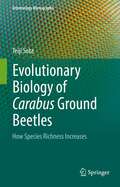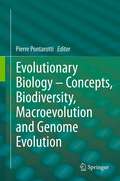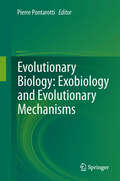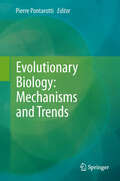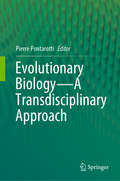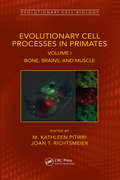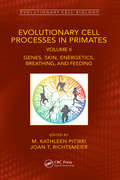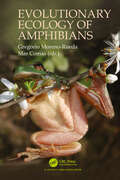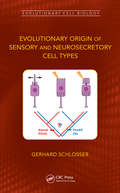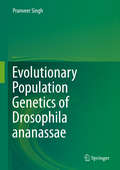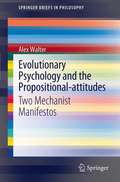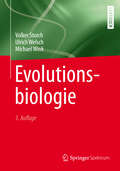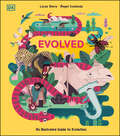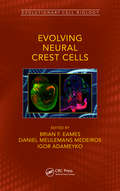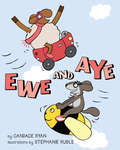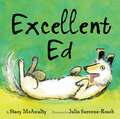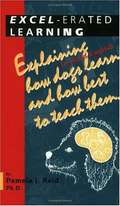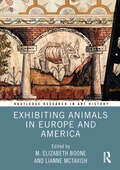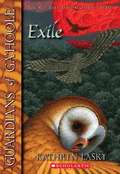- Table View
- List View
Evolutionary Biology of Carabus Ground Beetles: How Species Richness Increases (Entomology Monographs)
by Teiji SotaThis book presents the whole picture of the ecological and evolutionary study on the ground beetle group, the subgenus Ohomopterus of the genus Carabus, endemic to Japan. This flightless beetle group consists of many geographic races. They show divergence in key traits for reproductive isolation—body size and genital morphology, which leads to coexistence of two or more species. This beetle group provides an important material to study how a lineage of organisms diversify and form multi-species assemblage, and thereby multiply their species richness. The book introduces novel genomic approaches to resolve questions about evolution of Ohomopterus. The readers will find that this story of evolution in Carabus beetles revealed by recent approaches is much different from what was told in previous literature.Exploring different cases across a wide range of lineages is important in constructing a synthetic theory of species radiation and richness, including speciation and species coexistence. This study on Ohomopterus beetles contributes to the ongoing discussion to understand how and why species multiply and how species richness increases in one area of our planet.
Evolutionary Biology – Concepts, Biodiversity, Macroevolution and Genome Evolution
by Pierre PontarottiThe annual Evolutionary Biology Meetings in Marseilles serve to gather leading scientists, promote the exchange of ideas and encourage the formation of international collaborations. This book contains the most essential contributions presented at the 14th Evolutionary Biology Meeting, which took place in September 2010. It comprises 19 chapters organized according to the following categories: · Evolutionary Biology Concepts · Biodiversity and Evolution · Macroevolution · Genome Evolution Offering an up-to-date overview of recent results in the field of evolutionary biology, this book is an invaluable source of information for scientists, teachers and advanced students.
Evolutionary Biology: Exobiology and Evolutionary Mechanisms
by Pierre PontarottiThis book presents 19 selected contributions to the 16th Evolutionary Biology Meeting, which took place in September 2012 in Marseilles. The aims of these annual meetings, which gather together leading evolutionary biologists and other scientists, are to promote the exchange of ideas and to encourage interdisciplinary collaborations. The first chapter deals with the history of a great discovery: The first experiments on ascidian and sea urchin egg fertilization. The remaining contributions are grouped under the following categories: · Evolutionary biology concepts · Exobiology and the origin of life · Evolutionary mechanisms Offering an up-to-date overview of recent findings in the field of evolutionary biology, this book is an invaluable source of information for scientists, teachers and advanced students.
Evolutionary Biology: Mechanisms and Trends
by Pierre PontarottiThe annual Evolutionary Biology Meetings in Marseilles serve to gather leading evolutionary biologists and other scientists using evolutionary biology concepts, e.g. for medical research. The aims of these meetings are to promote the exchange of ideas and to encourage interdisciplinary collaborations. This book collects 19 selected contributions presented at the 15th meeting, which took place in September 2011. It starts with a description of the life and work of J.B.S. Haldane, a remarkable evolutionary biologist of the 20th century. The remaining chapters are grouped under the following three themes: · New Concepts in Evolutionary Biology · Macroevolution: Mechanisms and Trends · Genome Evolution Offering an up-to-date overview of recent results in the field of evolutionary biology, this book is an invaluable source of information for scientists, teachers and advanced students.
Evolutionary Biology—A Transdisciplinary Approach
by Pierre PontarottiThis book includes 16 selected contributions presented at the 23rd Evolutionary Biology Meeting, which took place in Marseille in September 2019. The annual Evolutionary Biology Meetings in Marseille serve to gather leading evolutionary biologists and other scientists using evolutionary biology concepts, e.g. for medical research. The aim of these meetings is to promote the exchange of ideas to encourage interdisciplinary collaborations. Offering an up-to-date overview of recent findings in the field of evolutionary biology, this book is an invaluable source of information for scientists, teachers and advanced students.
Evolutionary Cell Processes in Primates: Bone, Brains, and Muscle, Volume I (Evolutionary Cell Biology)
by M. Kathleen Pitirri Joan T. RichtsmeierMany complex traits define the human condition, including encephalization and bipedalism. The specific molecular signals and cellular processes producing these traits are the result of dramatic evolutionary change. At the same time, conservation of many of these developmental programs underlie both structure and function. Novel methodologies and techniques allow analysis of the collective behavior of cells, cell shapes, tissues, and organs. This volume demonstrates the essential role of cellular mechanisms in the evolutionary increase in the size and complexity of the primate brain. In addition, and concordant with encephalization, this book documents changes in the muscles and bones associated with the appearance of bipedalism. Genetic changes are the basis of these evolutionary changes, but transformation of genetic information into phenotypic outcomes occurs at the level of the cell, and this is the focus of the book. The goal is to encourage others to adopt evolutionary cell biology as a novel and necessary approach to the genotype-phenotype map of the diversification of primates, human variation, and human evolution. The contributors to this book utilize advances in genetic analysis, visualization of cells and tissues, and the merging of evolutionary developmental biology with evolutionary cell biology to address questions central to understanding the human and primate evolution. Key Features Explores mechanisms underlying trait distribution, dispersal, variation, and evolution through the direct testing of hypotheses especially with respect to patterns of encephalization, certain sensory modalities, and growth and life history specializations. Documents the advantages for anthropologists to work at the level of cells focusing on how genes provide instructions for cells to make structure and how environmental influences affect the behavior of cells. Illustrates the role cell biology plays with respect to encephalization, neocortical expansion, variation in facial morphology, locomotion, and dexterity. Describes novel methodologies and techniques allowing analysis of how the collective behavior of cells shapes tissues and organs. Related Titles Ripamonti, U., ed. Induction of Bone Formation in Primates: The Transforming Growth Factor-beta 3 (ISBN 978-0-3673-7740-3). Gordon, M. S., et al., eds. Animal Locomotion: Physical Principles and Adaptations (ISBN 978-0-3676-5795-6) Bianchi, L. Developmental Neurobiology (ISBN 978-0-8153-4482-7)
Evolutionary Cell Processes in Primates: Genes, Skin, Energetics, Breathing, and Feeding, Volume II (Evolutionary Cell Biology)
by M. Kathleen Pitirri Joan T. RichtsmeierMany complex traits define the primate condition, including behaviors as fundamental as locomotion and traits as scrutinized as the dentition, and their study reveals dramatic evolutionary change across the primates. Genetic modifications are at the basis of these changes, but transformation of genetic information into phenotypes occurs at the level of the cell, which is the focus of this book. Contributors summarize novel methodologies to analyze the collective behavior of cells in forming tissues and organs influencing physiological functions and anatomical features that enable behaviors. Our goal is to review current knowledge and encourage others to adopt evolutionary cell biology to aid in deciphering the genotype-phenotype map that underlies the diversification of primates, human variation, and human evolution. The contributors to this book utilize advances in genetic analysis and visualization of cells and tissues and merge evolutionary developmental biology with evolutionary cell biology to address questions central to understanding human and primate evolution. Key Features Explores mechanisms underlying trait development, distribution, variation, and evolution, especially with respect to pigmentation, dental formulae, the skeleton, energetics, and temperature-related morphological variation Documents the advantages for anthropologists to work at the level of cells, focusing on how genes provide instructions for cells to make structure and how environment affects the behavior of cells Illustrates the role cell biology plays in pelage growth and pigmentation, facial morphology, melanin production in pigmentation, dental development and tooth loss, and energy expenditure Describes novel methodologies and techniques to analyze environment- and temperature-related influences on phenotypes Demonstrates how significant changes in life history occur at the level of the cell Related Titles Bianchi, L. Developmental Neurobiology (ISBN 978-0-8153-4482-7) King, G. R. Primate Behavior and Human Origins (ISBN 978-1-138-85317-1) Rhys Evans, P. H. The Waterside Ape: An Alternate Account of Human Evolution (ISBN 978-0-367-14548-4)
Evolutionary Ecology of Amphibians
by Gregorio Moreno-Rueda Mar ComasAmphibians are the oldest tetrapod group and show an astonishing diversity in lifestyles, many of them being unique. However, globally, they are on a decline. Hence, their study is fundamental to understanding the evolution of diversity and conserving them. This book, authored by experts from around the world, summarizes the current knowledge on the evolutionary ecology of amphibians. The book treats biological concepts related to the evolution, ecology, physiology, immunology, behaviour, and morphology of amphibians in their different states. This book constitutes an actualized work indispensable for evolutionary ecologists and herpetologists.
Evolutionary History of Bats
by Nancy B. Simmons Gregg F. GunnellAdvances in morphological and molecular methods continue to uncover new information on the origin and evolution of bats. Presenting some of the most remarkable discoveries and research involving living and fossil bats, this book explores their evolutionary history from a range of perspectives. Phylogenetic studies based on both molecular and morphological data have established a framework of evolutionary relationships that provides a context for understanding many aspects of bat biology and diversification. In addition to detailed studies of the relationships and diversification of bats, the topics covered include the mechanisms and evolution of powered flight, evolution and enhancement of echolocation, feeding ecology, population genetic structure, ontogeny and growth of facial form, functional morphology and evolution of body size. The book also examines the fossil history of bats from their beginnings over 50 million years ago to their diversification into one of the most globally wide-spread orders of mammals living today.
Evolutionary Origin of Sensory and Neurosecretory Cell Types: Vertebrate Cranial Placodes, volume 2 (Evolutionary Cell Biology)
by Gerhard SchlosserMost vertebrate cranial sense organs arise from placodes. These placodes give rise to sensory neurons that transmit information to the brain and neurosecretory cells. This book reviews the evolutionary origin of the sensory and neurosecretory cell types. It summarizes our current understanding of vertebrate evolution, clarifies conceptual issues relating to homology and evolutionary innovation of cell types, compares the sensory and neurosecretory cell types with similar cell types in other animals, and addresses the question of how cranial placodes evolved as novel structures in vertebrates by redeploying pre-existing and sometimes evolutionarily ancient cell types.
Evolutionary Population Genetics of Drosophila ananassae
by Pranveer SinghThis book introduces readers to classical population genetics and the ways in which it can be applied to practical problems, including testing for natural selection, genetic drift, genetic differentiation, population structuring, gene flow and linkage disequilibrium. It provides a comprehensive monograph on the topic, addressing the theory, applications and evolutionary deductions, which are clearly explained using experimental results. It also offers separate chapters on origin, establishment and spread of chromosomal aberrations in populations along with details of culturing, maintaining and using Drosophila ananassae (genetically unique and the most commonly used species along with D. melanogaster) for genetic research. Encompassing topics like genetics, evolution, Drosophila genetics, population genetics, population structuring, natural selection and genetic drift in considerable detail, it provides a valuable resource to undergraduate and postgraduate students, as well as researchers at all level. This book explores some fundamental questions concerning the role of natural selection and genetic drift on the degree of inversion polymorphism. India, with its wide diversity in geo-climatic conditions, provides an excellent platform to conduct such studies. The book showcases sampling records of inversion frequencies in natural Indian populations of D. ananassae that cover more than two decades. It highlights case studies in which sampling data on inversion frequencies was combined with that from earlier surveys, generating a time series that allows the evolutionary dynamics of inversion polymorphism to be explored. Such long time series are rare but nonetheless crucial for studying the evolutionary dynamics of inversion polymorphism. The population-genetic analysis discussed is unprecedented in terms of its temporal (two decades) and spatial (most regions of India covered) scale and investigates the patterns of polymorphic system in D. ananassae to see if there is any temporal divergence. It endeavors to present a holistic picture of inversion polymorphism across the country (India). Chromosomal aberrations, particularly paracentric inversions, are used as a tool for discussing population genetic studies, helping human geneticists, gynecologists and other medical professionals understand why some aberrations are fatal in humans, with affected embryos often not surviving the first trimester of pregnancy, while similar aberrations in Drosophila flies aid in their adaptation to the environmental heterogeneity across the globe.
Evolutionary Psychology and the Propositional-attitudes
by Alex WalterThe two essays provide a critical examination of theory and research in the field of evolutionary psychology. The view advanced here is that philosophical materialism and minimalist assumptions about adaptation serve Darwinian psychology better than the more popular alternative view that relies on cognitive dualism and propositional-attitude psychology to formulate evolutionary psychology theory. A commitment to cognitive dualism is destined to undermine the physical basis of behavior upon which evolutionary theory depends. Many evolutionary psychologists do not see this but are seduced by the easy way in which hypotheses can be formulated using the 'propositional-attitude' model. The challenge is to develop a materialistic and mechanistic approach to understanding human cognition and behavior, including linguistic and social behavior.
Evolutionary Psychology and the Propositional-attitudes: Two Mechanist Manifestos (SpringerBriefs in Philosophy)
by Alex WalterThe two essays provide a critical examination of theory and research in the field of evolutionary psychology. The view advanced here is that philosophical materialism and minimalist assumptions about adaptation serve Darwinian psychology better than the more popular alternative view that relies on cognitive dualism and propositional-attitude psychology to formulate evolutionary psychology theory. A commitment to cognitive dualism is destined to undermine the physical basis of behavior upon which evolutionary theory depends. Many evolutionary psychologists do not see this but are seduced by the easy way in which hypotheses can be formulated using the ‘propositional-attitude’ model. The challenge is to develop a materialistic and mechanistic approach to understanding human cognition and behavior, including linguistic and social behavior.
Evolutionsbiologie
by Michael Wink Volker Storch Ulrich WelschDie gut eingeführte "Evolutionsbiologie" von Volker Storch, Ulrich Welsch und Michael Wink liegt inzwischen in 3., sehr gründlich überarbeiteter und aktualisierter Neuauflage vor. Die Autoren schildern den bisherigen Ablauf der Evolution der Organismen durch die Jahrmillionen, die molekularen Grundlagen der Evolution und - unter verschiedenen Aspekten - die Evolution des Menschen und seiner nächsten Verwandten. Zahlreiche Exkurse, viele von renommierten Wissenschaftlern verfasst, erläutern besonders aktuelle Themen.
Evolutionsbiologie
by Michael Wink Volker Storch Ulrich WelschDie gut eingeführte "Evolutionsbiologie" von Volker Storch, Ulrich Welsch und Michael Wink liegt inzwischen in 3., sehr gründlich überarbeiteter und aktualisierter Neuauflage vor. Die Autoren schildern den bisherigen Ablauf der Evolution der Organismen durch die Jahrmillionen, die molekularen Grundlagen der Evolution und - unter verschiedenen Aspekten - die Evolution des Menschen und seiner nächsten Verwandten. Zahlreiche Exkurse, viele von renommierten Wissenschaftlern verfasst, erläutern besonders aktuelle Themen.
Evolved: An Illustrated Guide to Evolution
by Lucas RieraFollow the story of evolution! The illustrated children&’s book is a beautiful introduction to the evolution of species over millions of years.What&’s made animals survive and naturally go extinct? Why are fish scaled? Why do birds have wings? Find out about the changing animal anatomy discoveries made by Swedish zoologist Charles Linneas.Animals and evolution are fascinating subjects to teach little minds. Discover the ways that animals have adapted to survive and the amazing reasons behind these adaptations. The illustrated guide includes: • Beautiful artwork, perfect for fans of Owen Davey. • Many different animal features (like eyes, scales, claws, hair and many more), as well as feature spreads on topics like fast evolution. • Highly accessible text about a key school subject. Kids age 7 and older will be delighted by the scientific facts in this wildlife book. It&’s filled with incredible bits of information that spark a deep curiosity in the natural world, evolution and the animal kingdom. The book highlights that evolution is an ongoing process, and allows kids to look at the world around them and notice the continuing evolution of species. Evolved also features more in-depth explanations of animal body parts, how they work and how they&’re different from other species. Children will understand how evolution made certain elements of the natural world unnecessary, and others integral to survival. Explanations of Charles Linneas&’ classification system of all living things are included and give kids, adults and educators a fantastic reference to the magnificent living world.
Evolving Animals
by Wallace Arthur Stephen ArthurWhat do we know about animal evolution in the early twenty-first century? How much more do we know today than Darwin did? What are the most exciting discoveries that have been made in the last few decades? Covering all the main animal groups, from jellyfish to mammals, this book considers all of these questions and more. Its 30 short chapters, each written in a conversational, nontechnical style and accompanied by numerous original illustrations, deal equally with the pattern and the process of evolution - with both evolutionary trees and evolutionary mechanisms. They cover diverse evolutionary themes, including: the animal toolkit, natural selection, embryos and larvae, animal consciousness, fossils, human evolution, and even the possibility of animal life existing elsewhere than on Earth. This unique text will make an excellent introduction for undergraduates and others with an interest in the subject.
Evolving Neural Crest Cells (Evolutionary Cell Biology)
by Brian F. Eames Daniel Meulemans Medeiros Igor AdameykoVertebrates possess lineage-specific characteristics. These include paired anterior sense organs and a robust, modular head skeleton built of cellular cartilage and bone. All of these structures are derived, at least partly, from an embryonic tissue unique vertebrates - the neural crest. The evolutionary history of the neural crest, and neural crest cells, has been difficult to reconstruct. This volume will use a comparative approach to survey the development of the neural crest in vertebrates, and neural crest-like cells, across the metazoa. This information will be used to reveal neural crest evolution and identify the genomic, genetic, and gene-regulatory changes that drove them. Key selling features: Summarizes the data regarding neural crest cells and nerural crest derivatives Uses a broad-based comparative approach Suggests hypothesis that the origin of neural crest cells involved the novel co-activation of ancient metazoan gene programs in neural border cells Illustrates how the emergences of neural crest made possible the diversification of vertebrate heads
Ewe and Aye
by Candace RyanEWE was a sheep with a feel for wheels. AYE was a lemur with a thing for wings. BUT it wasn't until Ewe and Aye found one another that things really got off the ground. Whimsical word play and heartfelt humor work hand-in-hand in this irresistibly vibrant celebration of the unlimited possibilities of togetherness.
Excellent Ed
by Stacy McAnultyDog lovers will adore this imperfect yet endearing mutt and his quest for excellence!***Winner of an Ezra Jack Keats New Author Honor Award!*** Everyone in the Ellis family is excellent--except Ed. Ed wonders if this is why he isn&’t allowed to eat at the table or sit on the couch with the other children. So he&’s determined to find his own thing to be excellent at--only to be (inadvertently) outdone by a family member every time. Now Ed is really nervous--what if he&’s not excellent enough to belong in this family? This funny and endearing story offers a subtle look at sibling rivalry and self esteem, and will reassure kids that everyone is excellent at something, and that your family loves you, just as you are.Praise for Excellent Ed:"A dog lover&’s delight." —School Library Journal"In Julia Sarcone-Roach&’s joyful, expressive paintings, we see Ed pondering how to demonstrate excellence. The answer is excellent, and entirely endearing." —The Wall Street Journal&“A warm, welcome reminder that everyone is excellent at something.&” —Kirkus Reviews starred review&“In a word? Excellent.&” —The Horn Book starred review
Excellent Pets
by RolliWhat animal makes the best pet? A tiger? A grizzly bear? A T-Rex? A killer whale? Or a puppy? Learn why all but one of these animals make great pets and all the things you need to do to properly care for your special pet!
Exel-erated Learning: Explaining in Plain English How Dogs Learn and How Best to Teach Them
by Pamela J. ReidThe book reveals the secret for increasing the speed and efficiency of dog training. With the freedom of understanding "how your dog learns" comes the ability of making the process easy, efficient and enjoyable for your dog.
Exhibiting Animals in Europe and America (Routledge Research in Art History)
by M. Elizabeth Boone Lianne McTavishThis edited volume, written by historians of art and visual culture who are working in the field of animal studies, seeks to understand how our ways of positioning (and ex-positioning) animals have separated us from the other-than-human animals that are an integral part of our interconnected world.Bringing together the visual and material culture of display with recent theoretical study on human–animal relations, the book draws attention to ways in which we might rethink this history and map pathways for the future. Defining the idea of exhibition and display broadly, chapters consider a diverse range of media, including paintings, anatomical sculpture, books, prints, and clothing; exhibition venues that take place in both the public and private realms; and key ideas such as looking at/looking back, seeing/being seen, and interspecies recognition. The authors cover topics that span the sixteenth through the early twentieth centuries and focus geographically on Europe and America, with significant content related to Canada, Indigenous America, and Latin America.The book will be of interest to scholars working in art history, visual studies, museum studies, animal studies, and environmental humanities.
Exhibiting Animals in Nineteenth-Century Britain
by Helen CowieIn an era of overseas exploration and imperial expansion, exotic animals were among the many foreign commodities to appear on British soil. They were a source of fascination to people across the social spectrum and served simultaneously as objects of entertainment, enlightenment and reflection. Focusing on zoos and travelling menageries in the period 1800-1880, Exhibiting Animals in Nineteenth-Century Britain explores how contemporaries thought about rare animals, where they encountered them and what symbolic, pedagogic and scientific value they attached to them. Helen Cowie uses animal exhibitions as a vehicle through which to examine issues of race, class, gender and colonialism. She devotes particular attention to travelling menageries, whose appeal transcended social boundaries and whose star exhibits included female lion tamers, 'ravenous hyenas' and pistol-firing elephants.
Exile (Guardians of Ga'hoole #14)
by Kathryn LaskyIn Exile, the book #14 of Guardians of Ga'Hoole Series, The Striga, former dragon owl from the Middle Kingdom beyond the Unnamed Sea, has come to stay at the great tree. He has earned the trust of all by saving Bell, Soren's owlet, from Nyra, and he grows daily closer to the young king Coryn, with whom he seems to share a strange bond.
